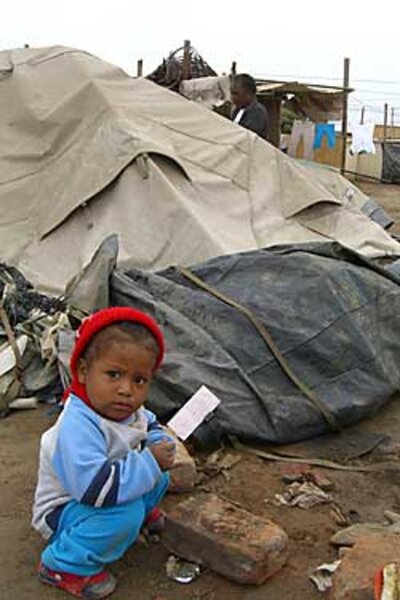In Peru, recovery from quake lags
Loading...
| pisco, peru
Two years have passed since a magnitude-8 earthquake flattened this Peruvian city. Today, much of Pisco remains in ruins. Women recover from childbirth in tents outside the heavily damaged hospital. The local government is run out of a cluster of wooden prefabricated homes. And until the mayor ordered them to move two months ago, hundreds of people lived in tent communities on the city's soccer fields.
Aug. 15 marked the second anniversary of a quake from which this small working-class port city, four hours south of Lima, is still recovering. Three terrifying minutes left more than 500 people dead across the region, more than a thousand injured, and 80 percent of Pisco's buildings uninhabitable.
Two years later, residents are disillusioned with the pace of reconstruction. Many use the word "forgotten."
"The government hasn't remembered us at all," says Aurora Garcia, who lived on a soccer field for nearly two years. Tears welled up: What was taking so long?
Relief workers and experts who study natural disasters say several factors impede reconstruction, not only in Pisco but across the developing world:
•Most governments do little predisaster planning.
•International sympathy – and funding – dry up quickly. Except in rare cases like the massive Asian tsunami or hurricane Katrina, disasters fade from global consciousness within days.
•Relief is often directed from central government agencies far from the disaster area, which can cause distribution bottlenecks.
•Since victims tend to be disproportionately poor and marginalized, improving their lot rarely tops government agendas. This problem is why many relief workers object to the term "natural disaster."
Rapid urbanization is causing more people to build on marginal land that is most at risk to floods and earthquake damage. That means, aid workers say, that the disasters of the future will be larger and more frequent if nations don't learn from the past. "If, God forbid, there were another earthquake in the next few weeks, I'm afraid the country would exactly repeat the same mistakes," says Frank Boeren, Oxfam International's coordinator in Peru.
In the hours following the Pisco quake, rescuers clawed through the rubble of the San Clemente church, which had collapsed during an evening mass, killing nearly 150.
During the next few days, Mr. Boeren contends the Peruvian government did a good job evacuating the injured and removing the dead, though critics say it reacted too slowly. Then chaos set in, Boeren says, as poor coordination between local and national government caused confusion about where to house survivors.
Displaced communities set up encampments on vacant land without toilets or running water. Containers of aid rotted in the port. Babies fell into open sewage holes.
The mayor, Juan Mendoza Uribe, who lost his sister in the quake, said the system wasn't equipped to handle a disaster of such magnitude. "The people want to crucify me," he says. "But what can I do? I can't do more."
Poor predisaster planning is a common problem worldwide, says Michael Delaney, director of humanitarian response for Oxfam America. Yet a dollar invested up front saves $47 during a disaster, he says.
A few years ago, Oxfam tracked hurricanes crossing the Caribbean: The storms killed a few hundred people in Haiti and the Dominican Republic. They next hit Cuba, where maybe two died, then moved to Central America, claiming hundreds more lives.
The difference between Cuba and the other countries, Mr. Delaney says, is planning: Every year, Cuba shuts down for a day and requires residents to run through a hurricane simulation drill.
Some issues, including figuring out who owns what land, can take years, says Bob Laprade, tsunami recovery program director for the American Red Cross. In Banda Aceh, where the 2004 tsunami struck, offices storing land titles were destroyed, Mr. Laprade says. In Pisco, such titles often never existed – most people lived in adobe houses that had been in their families for generations.
Ideally, disasters provide opportunities to address underlying poverty and inequality, says Anthony Oliver-Smith, a professor emeritus at the University of Florida in Gainesville, Fla. Impoverished people could be relocated to safer land or their houses rebuilt to better withstand disasters.
"The problem is," Mr. Oliver-Smith said, "it's very often an opportunity that we don't take advantage of."
Earlier this summer, Pisco's mayor stood on the steps of the crumbling local university. About 100 people gathered to voice concerns.
One woman spoke about the rise in crime since the quake. Others complained that assistance had been unfair. A man in a wheelchair wept. "I have nothing, and no one has ever given me anything," he said.
The mayor promised him some building materials. The microphone crackled. There was a smattering of applause.






